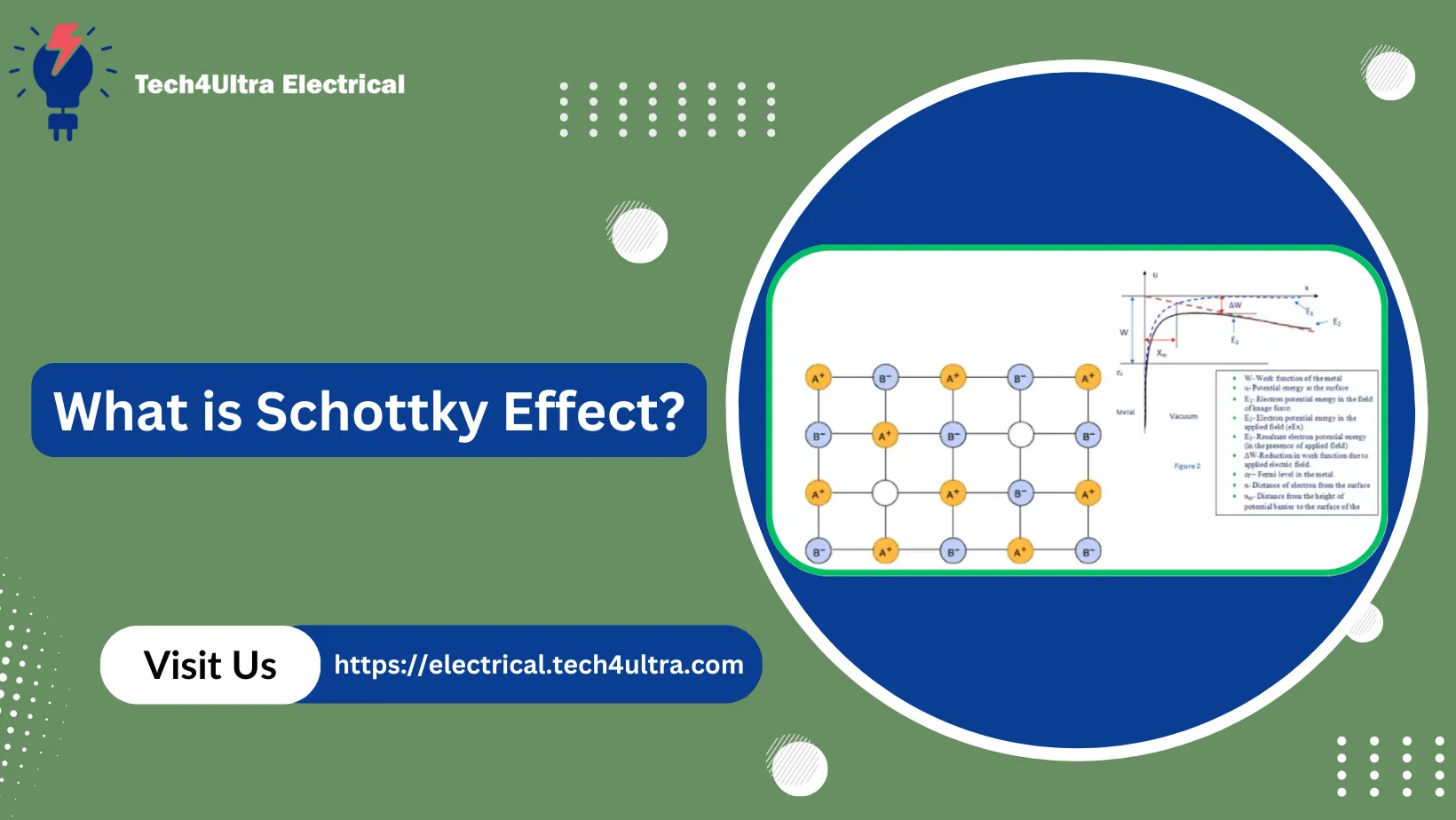Contents
Electron emission might sound like something reserved for physicists in lab coats and thick glasses, but it’s actually one of the most essential processes driving modern electronics. Whether you’re firing up a fluorescent light or tuning a vintage vacuum tube amplifier, electron emission is quietly doing the heavy lifting behind the scenes. In this article on the Tech4Ultra Electrical website, we’ll break down what electron emission is, how it works, and why it still matters in today’s technology.
Overview of Electron Emission Mechanisms
At its core, thermionic emission is the most straightforward mechanism: heat up a metal, and electrons gain enough energy to jump the potential barrier at the surface. Simple, right? But things get far more interesting when you factor in other phenomena like field emission and field enhanced thermionic emission.
These emission processes are what allow everything from X-ray tubes to cathode ray tubes (CRTs) to function. The efficiency and effectiveness of these systems often hinge on a material’s work function—the minimum energy needed for an electron to escape its surface.
Importance in Electronics and Vacuum Devices
Understanding electron emission is crucial if you’re dealing with vacuum devices or electron guns in scientific instruments. Devices that rely on controlled electron streams—like electron microscopes or high-frequency radio transmitters—live and die by the performance of their emission sources.
Brief Introduction to the Schottky Effect
Now here’s where it gets spicy. Enter the Schottky effect, a phenomenon where an applied electric field lowers the material’s work function, allowing electrons to escape more easily—even at lower temperatures. This isn’t just academic theory; it’s the reason many modern devices operate more efficiently, merging thermal and electric energy contributions in what’s known as field enhanced thermionic emission.
In short, think of the Schottky effect as the energy-saving cheat code for electron emitters. Instead of cranking up the heat, you just crank up the voltage.
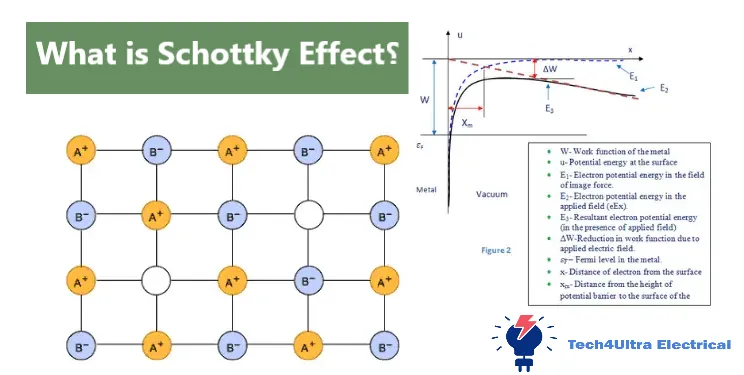
What is the Schottky Effect?
Clear Definition
The Schottky effect refers to the lowering of a material’s work function due to the influence of an external electric field. This reduction in energy barrier allows electrons to escape more easily from a metal surface, even if the temperature isn’t high enough for regular thermionic emission. When both thermal and electric contributions work together, the process is called field enhanced thermionic emission.
Historical Context: Walter H. Schottky’s Contribution
This phenomenon is named after the German physicist Walter H. Schottky, who first described it in the early 20th century. He was investigating ways to improve the performance of vacuum tubes and observed that the application of an electric field enhanced electron emission. Schottky’s insights were pivotal in explaining how external fields could manipulate surface barriers and contributed significantly to modern solid-state and vacuum electronics.
Where It Fits in Emission Physics
The Schottky effect serves as a bridge between pure thermionic emission and field emission. It’s particularly important in devices that need efficient electron flow without excessive heating, such as electron microscopes, cathode ray tubes, and even some modern field-emission displays. By integrating electric field effects into emission models, the Schottky effect allows for more accurate predictions and more efficient device designs.
Read Also: Arduino vs Raspberry Pi: Which One Should You Use?
The Physics Behind the Effect
Detailed Explanation of Thermionic Emission
Thermionic emission is a process where electrons escape from a material—usually a metal—when it is heated to a high temperature. As the metal’s temperature increases, electrons gain kinetic energy. Once their energy exceeds the material’s work function, they are able to overcome the surface potential barrier and leave the material. This principle is fundamental to vacuum tubes, thermionic converters, and cathodes in X-ray machines.
Role of the Electric Field in Modifying the Work Function
Now, here’s where things get more interesting. When an external electric field is applied to the metal surface, it influences the energy landscape of the electrons. Specifically, the electric field pulls on the negative electrons, reducing the height of the energy barrier they need to overcome. This phenomenon effectively reduces the work function—making it easier for electrons to escape the surface, even at lower temperatures.
Barrier Lowering Mechanism and Its Impact
This reduction in the potential barrier is what we call the Schottky effect. The barrier becomes “thinner” and lower, enabling electrons to tunnel through or jump over it more easily. This is why field enhanced thermionic emission is so powerful—it combines the thermal energy from heating with the electric energy from the field to significantly increase emission rates.
The result? More efficient electron emission with less energy input. This barrier-lowering mechanism is essential in designing energy-efficient electronic and vacuum devices, and it remains a key concept in emission physics to this day.
Schottky Effect vs Other Emission Mechanisms
Field Emission (Fowler-Nordheim Tunneling)
Field emission, described by the Fowler-Nordheim model, occurs when electrons tunnel through a surface potential barrier under a very strong electric field, even without significant heating. Unlike thermionic emission, it doesn’t rely on temperature. Instead, the intense electric field causes the electron wavefunctions to penetrate and escape through the potential barrier.
Thermionic Emission (Richardson-Dushman Model)
Thermionic emission is classically modeled by the Richardson-Dushman equation, which predicts the current density of emitted electrons based on temperature and the material’s work function. This mechanism dominates at high temperatures without a strong field presence. It’s a purely thermal process.
Comparison: Schottky vs Field vs Photoelectric Emission
| Emission Type | Primary Driver | Temperature Dependence | Electric Field Role |
|---|---|---|---|
| Thermionic Emission | Heat | High | None |
| Field Emission | Electric Field | Low/None | Strong |
| Schottky Effect | Heat + Electric Field | Moderate | Moderate |
| Photoelectric Emission | Light (Photon Energy) | None | None |
While field emission relies solely on strong electric fields and thermionic emission needs high heat, the Schottky effect blends both worlds for enhanced emission at moderate conditions. It’s a sweet spot that optimizes efficiency without extreme requirements.
Mathematical Derivation and Equations
Richardson-Dushman Equation: Origin and Limits
The classic thermionic emission current density is given by the Richardson-Dushman equation:
J = A T2 exp(−φ / kT)
Here, J is the current density, A is the Richardson constant, T is the absolute temperature, φ is the work function of the material, and k is the Boltzmann constant. This equation describes electron emission purely due to thermal energy, and it assumes no external electric field.
Its limitation? It breaks down under strong electric fields, where emission is no longer solely thermally driven.
Modified Richardson-Schottky Equation
To account for field enhanced thermionic emission, the Richardson-Dushman equation is modified by incorporating the Schottky effect, which lowers the barrier by Δφ:
J = A T2 exp[−(φ − Δφ) / kT]
Where the barrier reduction is:
Δφ = (e3 E / 4πε0)1/2
In this equation, E is the electric field strength, e is the electron charge, and ε0 is the vacuum permittivity. The result is a more realistic model for high-temperature devices influenced by electric fields.
Introduction to Murphy-Good Formalism
For precise modeling, especially near-field and at low temperatures, the Murphy-Good formalism is used. It refines the emission theory by incorporating quantum tunneling and field penetration effects, extending the classical models into regimes of ultra-high fields and small emission areas.
Explanation of Terms
- Boltzmann constant (k): Relates temperature to energy (1.38 × 10−23 J/K).
- Work function (φ): Minimum energy needed for an electron to escape the material’s surface.
- Electric field (E): The force per unit charge influencing electrons, measured in V/m.
These equations show how thermal and electric forces intertwine in the Schottky effect, making it essential in emission physics.
Factors Influencing the Schottky Effect
Temperature
Thermionic emission naturally increases with rising temperature, and so does the impact of the Schottky effect. As temperature rises, more electrons gain energy to escape the surface, and the presence of an external electric field further lowers the work function, making the emission process even more efficient.
Surface Material and Cleanliness
The type of material plays a huge role. Metals with a lower work function require less energy to emit electrons, making them more sensitive to the Schottky effect. But surface condition matters too—contamination or oxidation can increase the work function, reducing emission. Keeping the surface clean and polished is crucial for consistent performance.
Electric Field Intensity
The strength of the electric field directly determines how much the potential barrier is reduced. A stronger field means a more pronounced Schottky effect. However, fields that are too strong can lead to unwanted field emission instead of controlled thermionic-assisted emission.
Vacuum Level
The surrounding environment also matters. In a high-quality vacuum, emitted electrons travel freely without collisions. Poor vacuum conditions lead to scattering and recombination, effectively reducing the efficiency of field enhanced thermionic emission. So, maintaining a stable and clean vacuum is key for stable emission behavior.
Each of these factors influences the delicate balance that defines the efficiency and stability of electron emission via the Schottky effect.
Visualization and Diagrams
Understanding the Schottky effect is much easier with visuals. These diagrams highlight how the electric field modifies the work function, making it easier for electrons to escape. From potential barrier lowering to emission current variations with temperature, the visual models below simplify complex physics into intuitive graphics.
Energy Barrier Diagram
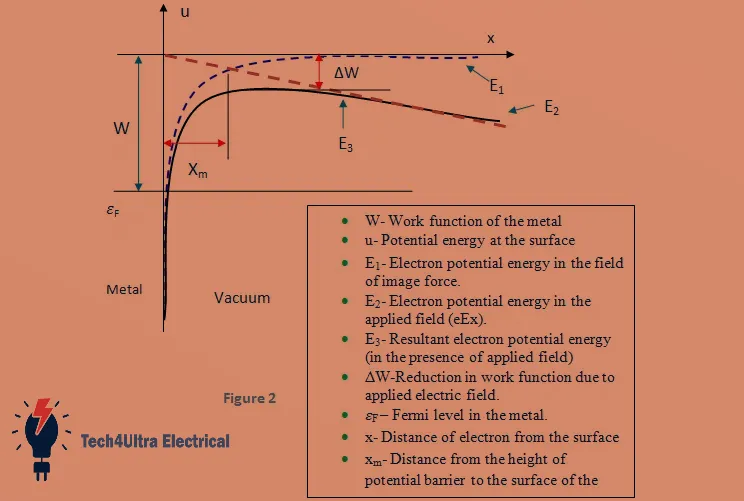
Illustration of how an electric field reduces the energy barrier for electron emission.
Field-Line Diagram
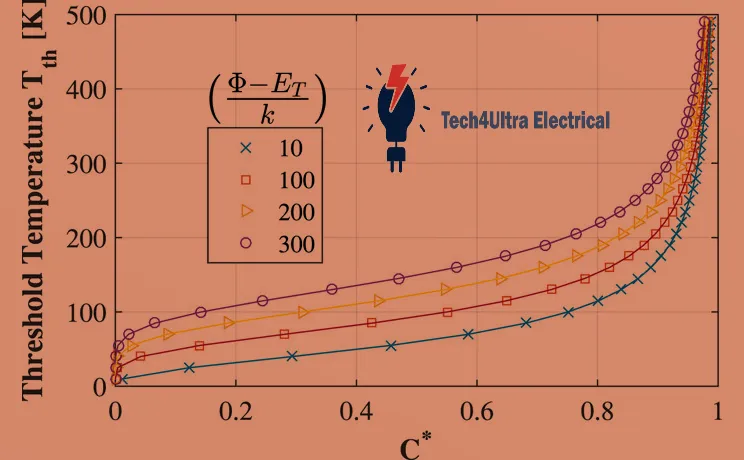
Electric field lines focused at a sharp tip enhance electron emission efficiency.
Emission Current vs Temperature
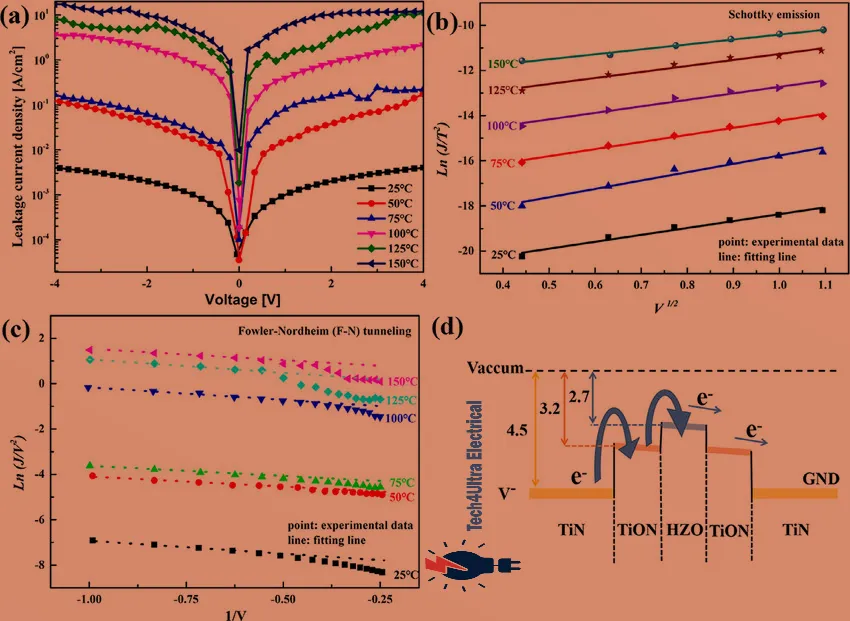
Graph showing increased emission current with rising temperature, enhanced further by the Schottky effect.
Applications in Modern Technology
Use in Vacuum Tubes, Electron Microscopes, X-ray Sources
The Schottky effect is a cornerstone in the operation of devices that rely on efficient electron emission. In vacuum tubes, it enhances current flow without requiring extreme temperatures. Electron microscopes benefit from more stable and controllable electron beams, improving imaging precision. Similarly, in X-ray sources, the effect allows for consistent electron generation needed to bombard the anode and produce X-rays effectively.
Role in Semiconductor Devices and Electron Guns
In semiconductor devices, especially Schottky diodes, the phenomenon is used to create fast-switching, low-capacitance junctions ideal for high-frequency applications. It also plays a crucial role in electron guns used in CRTs, particle accelerators, and high-precision instrumentation, where a reliable emission source is vital for beam stability and intensity control.
Experimental Validation in Lab Setups
The effect has been consistently validated in controlled laboratory environments. Researchers often use clean, ultra-high vacuum chambers to test thermionic emission under variable electric fields. Current vs. voltage and temperature curves show clear enhancement in emission when the Schottky effect is at play. These lab results match well with theoretical models like the Richardson-Schottky equation and Murphy-Good formalism, confirming the effect’s real-world relevance.
In essence, the Schottky effect is not just theory—it’s embedded in the very foundation of modern electronics and scientific instrumentation.
Experimental Setup and Observations
Suggested Laboratory Demonstration
A simple lab demonstration of the Schottky effect involves a heated metal cathode placed in a vacuum chamber. By applying a variable electric field across the cathode-anode gap and gradually increasing the temperature, you can observe enhanced electron emission. A sensitive ammeter connected in the circuit measures the current density emitted from the cathode.
Measuring Current Density Variations
To quantify the effect, you record current density as a function of temperature at several constant electric fields. When plotted, these measurements show a notable rise in current as temperature increases—more so in the presence of a strong field. This confirms field enhanced thermionic emission and aligns with the Richardson-Schottky equation.
Real-World Measurement Challenges
While the setup seems straightforward, real-world challenges complicate accurate measurements. Maintaining a clean surface is critical—any contamination alters the work function. Achieving ultra-high vacuum is necessary to prevent electron scattering. Also, precise control and calibration of the electric field and temperature sensors are essential to produce reliable data.
Despite these challenges, controlled lab experiments consistently validate the Schottky effect, reinforcing its significance in both theoretical and applied physics.
Challenges and Limitations
Accuracy of Theoretical Models
While models like the Richardson-Schottky equation and Murphy-Good formalism offer great insight, they still simplify complex real-world behavior. Assumptions like uniform surface fields and idealized emission areas often introduce errors when applied to practical devices. Predicting exact thermionic emission behavior under varying electric fields remains a challenge.
Material Limitations
Not all materials respond equally to the Schottky effect. Only a few metals exhibit the right combination of low work function, high thermal stability, and conductivity. Additionally, high operating temperatures can degrade materials over time, limiting their lifespan and reliability in repeated use.
Surface Work Function Inconsistencies
One of the biggest practical issues is surface cleanliness. Oxidation, adsorbed gases, or surface roughness can all raise the work function and drastically alter emission efficiency. Even minor contamination can disrupt current measurements and skew experimental results.
In short, while powerful, the Schottky effect is sensitive to real-world variables that often require precise control and calibration.
Conclusion
The Schottky effect plays a critical role in enhancing thermionic emission by lowering the work function through the application of an external electric field. This phenomenon enables efficient electron flow in devices ranging from vacuum tubes to advanced semiconductor components and electron guns.
Its integration into theoretical models and experimental setups has significantly advanced our understanding of emission physics. Despite certain limitations, the effect remains foundational in designing modern electronic and vacuum technologies.
FAQs
What is the Schottky effect?
The Schottky effect is the phenomenon where an external electric field reduces the work function of a material, making it easier for electrons to escape its surface. This effect enhances thermionic emission and is critical in high-efficiency electron emission systems.
What is the Schottky effect in solid-state?
In solid-state physics, the Schottky effect often refers to the lowering of the barrier at a metal-semiconductor junction. This leads to the formation of a Schottky diode, which exhibits fast switching and low forward voltage drop, commonly used in high-speed electronics.
What is the Frenkel and Schottky effect?
Both are defect-related phenomena in crystals. The Schottky effect involves the formation of pairs of missing cations and anions, creating vacancies. The Frenkel effect occurs when an ion leaves its lattice site and occupies an interstitial position, forming a vacancy-interstitial pair.
What do you mean by Schottky?
“Schottky” typically refers to phenomena or devices related to the work of Walter H. Schottky. It may indicate the Schottky effect, a Schottky diode, or other emission and semiconductor-related technologies that benefit from electric field-induced behavior.

